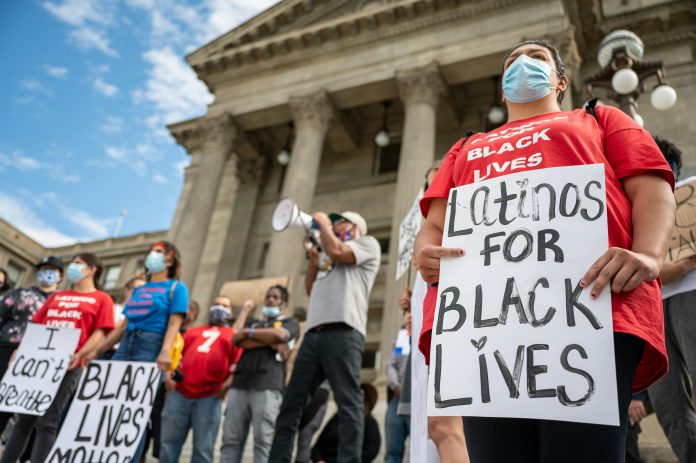
On the evening of Nov. 14, Dr. Jennifer Jones, associate professor of sociology and Latin American and Latino Studies at the University of Illinois Chicago, gave a talk on race and racial identity titled “Jim Crow to Juan Crow: Blackness, Latinidad, and Minority Linked Fate,” to DePauw students at the Peeler Auditorium.
The term “Juan Crow” was first coined by journalist Roberto Lovato, in 2008 when he criticized contemporary immigration enforcement laws by comparing them to Jim Crow laws. In that piece, he includes the rules, social customs, economic institutions and symbolic systems that enable the physical and psychic isolation needed to control and exploit undocumented immigrants. Laws in several states including Arizona, Alabama, Georgia, Texas and California’s 1994 proposition all fall under the rubric of Juan Crow Laws.
“It is important to underscore that these laws disproportionately impact Black and Latino, but not European and Asian migrants. I want to argue that this discursive move is a powerful indicator of the ways in which Latino people in the U.S., especially in the South, are seen and understood,” Jones said.
Over the last few decades, the demographics have changed drastically and census takers project that in the year 2045, the U.S. will have a majority-minority nation. There are already more non-whites born in the U.S. than whites for the first time, with Latinos making up the largest minority group.
They are settling in traditional destinations like California, Arizona and New York. An increasing number of recent immigrants are also moving to new destinations. However population change does not equate to political change.
“The U.S. is in fact changing, yet how Latinos are incorporated into American communities and are reshaping life in those communities, I think, it’s not yet well understood,” Jones said.
Jones built her analysis through a case study of Winston Salem in North Carolina, seeing as it experienced some of the “fastest and most dramatic” growth of the Latino population. They settled in stable middle-class African-American communities while whites were on the other side of the highway. By the 90s, Latinos were recruited to fill labor services and construction jobs and Blacks moved into white-collar jobs.
One of the respondents, a young woman from Guerrero, Mexico when she was 12 said, “In church, (Latinos and African Americans) work together. I know a lot of African Americans who want Latinos, who are here illegally, to become legal and they try to do something to help them.”
Ramon, another respondent said, “Supposedly they say that Blacks and Hispanics don’t get along, but it’s just much easier to call a black person a friend than an American. The Americans have treated the blacks badly to this day. They have the same problem we have – racism. And because of this, we get along better.”
Jones found that Latinos reported strong feelings of closeness and perceived Blacks as allies in the struggle against discrimination. This is important because many scholars have found that relations between Blacks and Latinos appear to be riddled with conflict, competition and a strong sense of group threat to a lesser extent. This is understood primarily as the assumption that Blacks and Latinos are at the bottom of the economic social structure, sharing this equal position, resulting in competition for resources including jobs, housing, health care and education.
“This contrasted greatly with what many Latinos’ perceptions of white Americans were in my study, who they were largely segregated from and perceived as discriminatory in distance,” Jones said. “So, because positive Black-Latino relations are neither predicted nor well explained by literature, how do I explain this option? With whom do you link your fate?”
Jones found that the fate of marginalized non-whites is linked to others who are like them or have similar economic status. This factor plays an important role in shaping race relations and racial identities “resulting in this dialectic set of reflections and relations whose perceptions about shared status also shape perceptions about the self.”
Specifically, Jones argued that first, low-resource competition is necessary for positive relations to occur. Second, you have to develop a shared racial status which can be done by “finding a perceived threat that can be ameliorated by sustaining positive contact, a shared sense of discrimination can facilitate positive relations, and a need for a perceived collective external threat to organize and frame relations against.”
The 287(g) Program, a 1996 immigration bill that allows local governments to partner with ICE and put locals into deportation facilities, was the external threat in this case. Another respondent, Lisa, said, “I feel afraid. I have a lot of fear for my children. I’m so afraid when I see an officer go by. I feel sick.”
“This growing sense of fear, marginalization while absolutely detrimental to the well-being of Mexicans was essential to building bridges between Blacks and Mexicans through this common experience of racism and discrimination,” Jones said. “ I also think that things have started to change.”
In 2018, Gary McFadden was one of 20 new Black sheriffs elected in Melon County, North Carolina where most ran on a platform of ending over policing of Black people. Gerald Baker also won the sheriff's race, beating longtime white Republican Donnie Harrison in Wake County. Dr. Jones no
